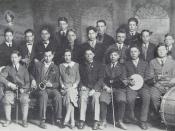Parenting is like a recipe, a dash of love and a pinch of discipline. An effective parenting method is treating each individual child according to their different levels. Treating them equally would be unfair. Reward and punishment are useful in rearing children; rewards enforce good behavior, and punishments make sure that the action does not become a habit. Parents take on the responsibility of teaching their children the ways of life. Yet, in The Scarlet Letter, the roles have been reversed. Pearl helps Hester and Dimmesdale reach their goal of salvation by rewarding and punishing their actions. However, because Hester and Dimmesdale are at different stages on their road to salvation Pearl treats them differently. Hester Prynne needs to be reminded and punished, and Dimmesdale needs to be urged to take the initial step towards confession.
Even as a baby, Pearl tormented Hester. During the first scaffold scene, the "first object of which Pearl seemed to become aware was .
. . the scarlet letter on Hester's bosom." As Hester tried to cover the "A" by holding Pearl in front of the scarlet letter, Pearl disapproved and cried out. Pearl torments her mother, and reminds her that the scarlet letter is a symbol of her sin, and that she should never try to conceal it. One day at the beach, Pearl placed green seaweed in the shape of an "A" on her bosom, just like her mother's "A." Then, she asked her mother of the importance of the letter, but Hester could not answer. Smart and determined, Pearl asked many questions about the scarlet letter and irked Hester further. Hester's uneasiness of answering the questions about the "A" causes her to deny its existence, and she tries to move on with her life. Pearl will not let her mother forget the "A" and its significance. Pearl keeps Hester on the narrow path toward salvation. As Pearl grows older, she understands the impact that the "A" has on her mother, and focuses more on the symbol. Strolling through the forest one day, Pearl comments that the sun does not shine on Hester "because it is afraid of something on [her] bosom." The reader can infer that Hester feels that the light of God does not shine on her because she has committed a sin. Pearl's comments cause Hester to think. Why does the sun not shine on me? This questioning tortures Hester further. Pearl punishes Hester out of love. To further torment her mother, Pearl lines the "A" with prickly burrs, as if to prick an "A" onto Hester's bosom. This signifies Pearl's wish to make sure that Hester never forgets her sin by stitching it into her mind. Trying to forget her sin, Hester rips off the letter and throws it near the brook. Pearl notices the vacancy on her mother's bosom from the other side of the brook, and demands that she pin it back on. Dimmesdale thinks that Pearl is an "elfish spirit . . . who is forbidden to cross a running stream." Hester only removed the scarlet letter so that she can be able to start a new life without the worries of the sin. Nevertheless, Pearl does not let Hester forget her sin, and it is Pearl who will lead Hester to her salvation.
Constant punishment is not effective; thus, praise and reward should be included. Pearl rewards Hester in different ways. One of Hester's rewards is Pearl's mere presence. Pearl keeps Hester from crossing the line toward the evil side, and thus helps Hester work for her salvation. Hester says, "she is my happiness! Pearl keeps [her] here in life." She adds that she would die first, if Pearl was ever taken from her. Hester remarks that "had they taken [Pearl] from me, I would willingly gone with [Mistress Hibbins] into the forest, and signed my name in the Black Man's book . . . with my own blood." Pearl keeps Hester sane, so that she will be saved. During the scene in the woods, after Hester fastens the "A" back onto her bosom, Pearl no longer seems like the "elf" that Dimmesdale described her to be. Pearl "bounds" across the brook, and "kisse[s] [Hester's] brow and both her cheeks." Pearl's reward reinforces the idea that Hester should not part with the scarlet letter because it will help her reach her goal.
Dimmesdale's punishments are different from Hester's. Pearl urges Dimmesdale to take the initial step of confession, and so he can reach salvation. During the first scaffold scene, Pearl directs a "vacant gaze" towards Dimmesdale, and holds "up [her] little arms." Pearl's action must have hurt Dimmesdale greatly because he denied his own daughter. The second scaffold scene was the climax for the character development of the characters. Dimmesdale stood on the platform, during the dark of night, with Hester and Pearl. Feeling as if they were an "electric chain," he felt rejuvenated. Dimmesdale did not want this feeling to end. For once he did not feel his heart aching. When Pearl asks Dimmesdale "Wilt thou stand here with mother and me, to-morrow noontide?," Pearl is asking Dimmesdale to recognize Pearl as his daughter, and to admit his sin. Thus, Pearl is Dimmesdale's conscience because she is asking him to do something that he wants to, but does not have the courage. Breaking the chain, Pearl exclaims: "Thou was not bold! - thou was not true!" This is a hard blow to Dimmesdale, and he is once again in agony. Dimmesdale is punished once again during a scene in the woods. Hester wants Pearl to meet and love Dimmesdale. However, after Dimmesdale kisses Pearl she runs to the brook and "bathe[s] her forehead, until the unwelcome kiss was quite washed off . . ." Pearl's action must have hurt Dimmesdale greatly because she did not welcome his love. Pearl wants Dimmesdale to first confess so that she can love him. She constantly tries to cajole Dimmesdale by asking if he would go back into town "hand in hand" with her and Hester. Once again, Dimmesdale is denying his little girl the right to call him her father, and this causes him more pain. Finally, during the Election Day parade, when Pearl notices Dimmesdale, she wants to run out to him and ask him to kiss her, but Hester does not let her. Pearl wants the people to know of Dimmesdale's sin during the day, so he can finally achieve salvation.
Like Hester, Dimmesdale is also rewarded. Dimmesdale's stand for Hester's right to raise Pearl, earns him affection from Pearl. She "carress[es] his hand " and kisses him gently on his forehead. This reward reinforces the idea that Dimmesdale was right for standing up for Hester, but he should follow through and speak of his sin. Dimmesdale was rewarded again during the second scaffold scene. The moment he felt the "electric chain" was pleasure. Dimmesdale did not want it to end. This was the feeling that he wanted to experience for the rest of his life. However, this feeling did not last because he did not want to stand there during the day, and thus Pearl broke the chain. Pearl was giving Dimmesdale a preview of the feelings that he might be able to feel if he was to confess. Dimmesdale is once again rewarded during the final scaffold scene. After Dimmesdale confesses, "Pearl kissed his lips." Pearl reinforces that his behavior was correct.
After Pearl's kiss, as the tears feel on her father's cheeks "they were the pledge that she would grow up amid human joy and sorrow, nor forever to do battle with the world, but be a woman in it." Pearl's mission was complete, she helped her parents reach salvation by punishing and praising them.





